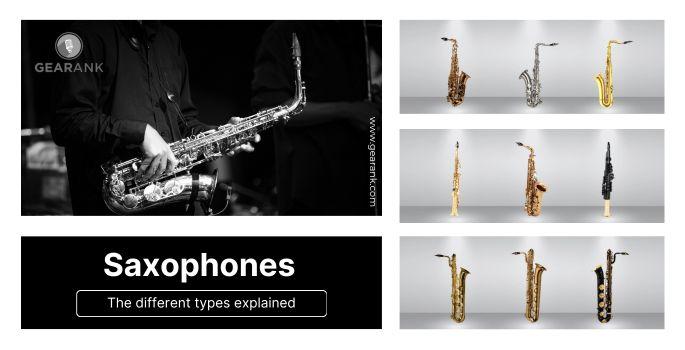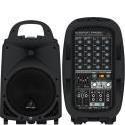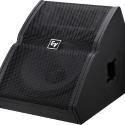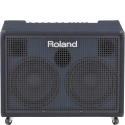Types of Saxophones and Choosing the Sound You Want

The alto saxophone is the most common among the many types of saxophones. This is the sax shape that most people have in mind.
But there is more to this wind instrument, with different types that allow for sonic variety.
This article will review the different types, their characteristics, history, and the reasoning behind their unique designs.
Before diving into the different variants, let's answer the basic question: what is a Sax
What Is A Saxophone?
This may come as a surprise to the uninitiated, given its metal exterior. But the saxophone is a single-reed woodwind instrument.
It is considered a woodwind instrument because of how it makes its sound.
The sax sound we love is produced when the saxophonist plays blows into the reed on the mouthpiece. This vibrates and creates the sound that moves through the instrument's body.
This conical body is commonly made from brass and other metals. This metal exterior is why many falsely identify the sax as a brass instrument.
But the sax makes it sound following the same principle for all woodwind instruments, including the flute and the clarinet.
The clarinet is the instrument that's closest to the sax because it's also a single-reed instrument.
A Short History Of The Saxophone
The saxophone is an iconic instrument that played a significant role in jazz music, bebop, and big band music from Chicago and New Orleans. But, oddly enough, it didn't begin with Jazz.
Invention Of The Saxophone
The saxophone was invented away from the Jazz movement. It was designed by Adolphe Sax, a Belgian who made the instrument as an orchestral wood instrument in the 1840s.
While the saxophone can be part of modern classical music ensembles today, it wasn't popular with the standard orchestra set up when Sax was alive.
Even so, the saxophone still appeared in famous musical pieces by Debussy and Shostakovich. There was even a School of Classical Saxophone at the Paris Conservatoire.
Originally, Adolphe Sax had 14 different types of saxophones in mind, including some pitched in F and C (the classic concert pitch). The variations grew in number with different sizes and pitch.
But of the many variants, four went on to be the main types that we have today. These are the soprano, alto, tenor, and baritone saxophones. Other variants exist, but they are usually specific to certain music genres.
The changing tastes in music also altered what sounds our modern saxophones produce today. From contrabass saxophone to baritone sax, most of these woodwind instruments today are pitched in B flat or E flat.
This configuration makes the sax viable for a much greater variety of music. You can hear it in rockabilly, pop, country, rock music, and traditional marching bands.
But Jazz is still the main musical style that comes to mind when the saxophone is mentioned. In fact, a saxophone player is often considered as a jazz musician by default.
All 14 Types of Saxophones
Instead of just focusing on the main four types (soprano alto tenor baritone), we will review the original 14 types and how they relate to music and saxophone players today.
I will start with the most popular saxophone types and talk briefly about the lesser-known saxophones at the end.
Soprano Saxophone
The soprano saxophone is one of the bigger types of saxophone. It resembles a clarinet, thanks to its straight body.
This being said, some saxophone manufacturers also create beautifully curved sopranos similar in size to alto saxophones.
This type of saxophone is a B flat instrument, a fifth above the alto and a whole octave above the tenor saxophone.
It is a widely used saxophone that has its challenges. Saxophone players need good control of intonation and breathing to handle this instrument well. When not played well, this instrument produces a piercing, squeaky sound.
This is one of the reasons why a soprano sax isn't the best option for beginners.
The soprano is a typical Jazz solo instrument, but it can also create a cutting sound as part of a typical saxophone quartet.
History Of The Soprano Sax
This kind of saxophone is most popular with Jazz saxophonists. It has a fascinating history closely entwined with the emergence of Jazz.
The Jazz soloist Sidney Bechet wasn't just famous for his clarinet music. He also shaped the sound of the soprano saxophone of the 1920s.
From the 1930s into the 1950s, the soprano sax almost disappeared during the rise of hard bop, cool Jazz, bebop, and swing.
Fortunately, saxophonist John Coltrane revived the soprano with his famous album "My Favourite Things," featuring some iconic saxophone sounds.
But plenty of other saxophone players recognized the soprano's distinctive sound, including Dave Liebman, Branford Marsalis, and Wayne Shorter.
This being said, these musicians also played other saxophones besides the soprano. Steve Lacy is one of the few saxophonists whose main instrument was a soprano.
Lacy's first album, "Soprano Sax," is a fantastic example of the delightful soprano sound.
Tenor Saxophone
The tenor sax is a B flat instrument slightly larger than the F alto saxophone.
But the curves near the neck easily distinguish these two saxophone family members.
A tenor saxophone has a larger reed and mouthpiece than a soprano saxophone and the alto.
The tenor sax is typically pitched an octave lower than the soprano, making it ideal for blues bands with plenty of rhythm and swing.
These saxophones have a rich and warm sound, which works well in a traditional Jazz ensemble and chamber music.
I always recommend the tenor to intermediate and advanced saxophonists who want a greater sound range than an alto.
History Of The Tenor Sax
This saxophone emerged onto the Jazz scene during the Swing era when saxophonist Coleman Hawkins worked with this fantastic instrument in the 1920s. "Imagination" is a great tenor sax piece.
This is why today, the tenor is the most-loved Jazz saxophone.
Alto Saxophone
This particular sax is the best beginner type of saxophone. It is an E-flat instrument lower than the soprano but higher pitched than the tenor.
Like other saxophone types, the alto ranges from just below B flat with two and a half octaves to F sharp.
History Of The Alto Saxophone
The alto saxophone rose to fame during the 1940s when it became the favorite instrument of Jazz saxophonist Charlie Parker. For example, in Parker's song "The Bird."
It is also often used in funky, smooth Jazz, Swing, and classical music. Altos are also part of the classic big bag lineup, where you have two alto saxophonists.
Many military bands, saxophone quartets, and concert bands include an alto saxophone to give their sound a distinctive voice.
Baritone Saxophone
The baritone saxophone is typically the biggest sax you can hear in Jazz. These massive saxophones are a fifth lower than a tenor sax and an octave lower than an alto.
As an E flat saxophone, baritones can go as low as the lower A, producing some unusual sounds for low-note songs.
A five-person saxophone ensemble usually has a baritone sax, although these low saxophones are also in big bands, funk, Motown, and concert bands.
While baritones aren't typical solo instruments, it is a favorite with many improvisers, including Gerry Mulligan, Harry Carney, and Lester Young.
"Line for Lyons" is a fabulous example of the bari sax from Gerry Mulligan and Chet Baker.
Sopranino Saxophone
The sopranino has the highest pitch of all saxophones but is also the smallest instrument of the saxophone family.
Sopraninos are typically straight saxophones, but some specialist manufacturers also focus on making curved sopranino saxophones.
It is an entire octave higher than an alto sax, but most musicians consider the sopranino a smaller alternative to the soprano sax.
Its airy and light sound is popular with orchestras and classical music. You may recognize this saxophone in Ravel's famous masterpiece "Bolero."
Saxophone players don't need a neckstrap with this saxophone because it is so small. While this small size makes the instrument extremely easy to carry, it is much more challenging to play.
You need excellent finger dexterity to work with all the intonations and high registers.
Sopranissimo
Also called the piccolo saxophone or soprillo, the sopranissimo is one octave higher than the soprano.
This type of saxophone is the only saxophone that Adolphe Sax did not initially design. Instead, it was developed and produced in the last decades.
Manufactured by the German instrument maker Benedikt Eppelsheim, the sopranissimo is extremely rare.
With a range up to high E, this saxophone has a slightly smaller range than other brands.
This makes it suitable for various contemporary music, although its rarity means these instruments are costly.
Bass Saxophone
Bass saxophones are large instruments that play B flat. It is an octave below a classic tenor and a fourth below the baritone sax.
These saxophones rose to fame with dance bands and Jazz bands in the 1920s. They were often played alongside the tuba, which paired well with the bass sax. There is even a bass clarinet.
Bass saxes were also popular in orchestral music during the 1950s and 60s, but you can hardly hear them as part of an ensemble t
This being said, basses are occasionally used for musical theater shows, such as the famous sheet music of West Side Story.
Contrabass Saxophone
The contrabass saxophone is rarely seen today on stage. It is an E flat instrument, a whole octave lower than the baritone sax.
This long saxophone produces such low pitches at the bottom of the registers that it can be difficult for beginners to tell the different notes apart.
It takes a well-trained ear to distinguish the various low tones that this saxophone can make. This makes it the ideal companion for new music ensembles and classic saxophone choirs.
Saying this, it is also a firm staple in contemporary music setups, like with the American rock band Violent Femmes.
Still, the contrabass sax is one of the different saxophones typically played by music experts who enjoy unusual instruments.
Subcontrabass Sax
The subcontrabass saxophone was initially called "saxophone bourdon" by Adolphe. Sadly, he spent a lot of time on the design of this instrument but never built it.
The subcontrabass sax is just two octaves below the tenor sax and one octave below the bass with a pitch in B flat.
This instrument is so unusual that some music historians even doubt it is part of the sax family. This is because it has some thin tubing and a narrow bore.
Plus, the subcontrabass also uses the same standard saxophone fingerings. Here is an example of Attilio Berni playing the large J'Elle Stainer sub-contrabass saxophone.
Tubax Saxophone
Designed and produced by Benedikt Eppelsheim at the end of the 1990s, the tubax is a complex instrument crafted with elements of the tuba and the sax.
This instrument has tubing that is folded several times, making it much more compact than most other saxes.
This sax pairs incredibly well with other types of saxophone, which makes it an interesting option for modern compositions.
Mezzo-Soprano Saxophone
This saxophone is commonly called the F-alto sax because it was designed in F. This is the only member of the saxophone family that uses the F key.
The mezzo-soprano sax is similar to an E flat alto but has an entire tone above a standard alto.
Similar to other saxophones produced at the end of the 1920s, they are extremely rare. Unfortunately, they were also not very popular at the time.
This is why the manufacturer C.G. Conn also made very few of these instruments.
When I researched the mezzo-soprano saxophone, I discovered they were popular instruments to teach instrument repair.
Shockingly, some repair instructors intentionally dropped these instruments on the floor to demonstrate the repair process to students.
While this made them worthwhile in some way, mezzo-soprano saxes saw few stage performances. Here is an example of the F mezzo sax on stage.
C Melody Saxophone
Sadly, the C-melody sax is another instrument you hardly ever see on stage today. That being said, it was trendy in the early 1900s.
This saxophone is smaller than a tenor but slightly larger than a classic alto saxophone. Just as the name suggests, it was pitched in C.
Its C key made the C-melody saxophone stand out from the crowd. You could play concert pitches with this instrument without transposing.
This made life much easier for musicians who didn't have to change their printed music initially designed for other C instruments, such as violin, piano, or flute.
This is a fantastic advantage for professional musicians and makes the C melody sax ideal for beginners.
Even if you don't use your saxophone for traditional Jazz or other pieces, you can still play novelty tunes and your compositions.
Plus, you can play this type of saxophone together with your friends, who may accompany you on other instruments.
Saxello
Originally known as a King Saxello, the saxello was an instrument designed and manufactured by the H. N. White Company during the 1920s.
It sounded similar to a B flat soprano, although it had a tipped bell and curved neck.
The production of saxellos stopped in the 1930s, and there are only a few collector instruments today. This also means that they are one of the most expensive saxophones.
Conn-O-Sax
I put the Conn-O-Sax at the end of my list of saxophone types because it is the rarest instrument of all saxophones.
Only 25 Conn-O-Sax saxophones are left today, all owned by private collectors.
Originally produced as a limited edition saxophone by C.G. Conn, this type comes with a three-octave range.
This wide range made it a revolution in the music industry during the late 1920s. But as the sound was so unusual, the manufacturer had to cut down on its production due to the Great Depression in 1929.
Although I never heard a Conn-O-Sax play myself, I was told by some lucky listeners that it has the most pleasant sound of all types of saxophones.
Frequently Asked Questions
What Are The 4 Most Common Saxophone Types?
The most common types of saxophones that musicians prefer to play today are the baritone saxophone, the soprano saxophone, the alto saxophone, and the tenor saxophone.
What Is The Best Type Of Saophone For Beginners?
The easiest saxophone to play for beginners is the alto saxophone. It is smaller and lighter than most other saxophone types.
An alto saxophone is also ideal for marching bands and saxophone players who prefer a lightweight instrument they can easily carry around.
Is Alto Or Tenor Sax Easier?
While alto and tenor saxophones produce a similar sound, an alto sax is much easier to manage thanks to its lighter weight and smaller size.
What Is The Rarest Saxophone?
The sopranissimo sax is the rarest type of saxophone ever produced. It was 33cm long but created the highest pitch in these windpipe instruments.
What Is The Best Sax Ever Made?
Many music lovers believe that the Mark VI saxophone was the most popular sax in the world because it was played by iconic saxophonists, such as John Coltrane, Dexter Gordon, and Phil Woods.
What Sax Is Most Used In Jazz?
There is no doubt that the tenor saxophone is the most popular Jazz saxophone for a great variety of Jazz music.
Its warm, rich tones and light weight make the tenor the perfect instrument for Jazz musicians like Charlie Parker and John Coltrane.
Are Older Saxophones Better?
Unlike a good wine or cheese, saxophones sadly don't get better with age. An older saxophone might even have a dull or squeaky sound compared to its new counterpart.
However, this depends on the instrument's condition and how well the owner looked after it.
Are Electronic Saxophones good?
Digital signal processing has improved enough to produce realistic feeling and sounding electronic wind instruments. And this includes the compact travel sax and the complex digital sax. Travel saxophones are designed to be portable. They have decent playability and sound, but they focus on convenience and mobility.
On the other hand, Digital saxophones, are designed to give you the playing feel and sound of a real saxophone, while offering convenient voice and tone switching. A good example of this is the Yamaha YDS-150.
Both electronic saxophone types are good for the purposes that they are made for. But they won't be replacing real saxophones any time soon, there are still ways to go for tech to get real close to the nuances of wind instrument playing.
Final Thoughts
While they all look similar, there are significant differences among the many types of saxophones. And each one can bring their own unique sonic flavor to a musical track.
I recommend going for the ever popular alto saxophone if you're a beginner. But any of the four main types can sound great in a modern setting.
Saxophones are mostly known for their part in Jazz ensembles, but they are just at home in orchestral music, marching bands, pop bands, rockabilly, and similar genres.











